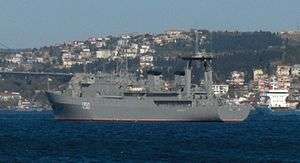Ukrainian command ship Slavutych
 Slavutych in Bosphorus in 2007 | |
| History | |
|---|---|
| Name: | Pridneprovie |
| Ordered: | July 1988 |
| Builder: | Black Sea Shipyard (Mykolaiv) |
| Launched: | 12 October 1990 |
| Commissioned: | 24 August 1992 |
| Renamed: | Slavutych |
| Identification: | U510 |
| Status: | Held arrested by Russia since 2014 |
| General characteristics | |
| Class and type: | Bambuk-class spy ship |
| Displacement: | 5,010 tons; 5,400 full tons |
| Length: | 106.5 m (349.4 ft) |
| Beam: | 16 m (52.5 ft) |
| Draft: | 6 m (19.7 ft) |
| Propulsion: |
|
| Speed: | 16 knots (30 km/h; 18 mph) |
| Range: | 8,000 nmi (15,000 km; 9,200 mi) at 12 knots (22 km/h; 14 mph) |
| Complement: | 178 |
| Sensors and processing systems: | Radar: 3 x Palm Frond |
| Electronic warfare & decoys: | 2 x PK-16 decoy |
| Armament: |
|
The Ukrainian command ship Slavutych is a former Soviet auxiliary ship Prideprovie of the Gofri-class intelligence ships (NATO codename: Bambuk)[1] ship built for the Soviet Navy in the late 1980s.
Description
The ship was designed by the Central Design Bureau "Chernomorets" in Sevastopol, Ukrainian SSR initially for the purpose to serve the nuclear submarines of the Soviet Northern Fleet.[1] It was planned to realize the project based on a big refrigerated fishing trawler (BMRT) project 1288 and placed in a dock of the Black Sea Shipyard as a special ship SSV-189.[1] Due to dissolution of the Soviet Union, the construction was abandoned and continued by the newly formed early administration of the Ukrainian Navy.[1] It was decided to reequip the warship as a big spy ship project 1288.4 as "Prydniprovia".[1]
Ukrainian service
On the Ukrainian independence day 24 August 1992 the former Pridneprovie ship was renamed Slavutych and commissioned into the Ukrainian Navy. In 1994 its ship identification number was switched from 800 to U510.
Fate
Slavutych was taken over by Russians during the 2014 Crimean crisis.
See also
References
External links
- U-510 Slavutich. BLACK SEA - HISTORY OF VISITS